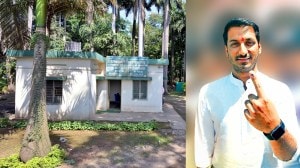Break Point
While the ship-breakers sit in their air conditioned cabins with swank cars parked outside, the workers toil under the harsh sun. Wearing ve...

And then you see them. The gigantic ships at Alang, the world’s biggest ship-breaking yard. The steely bodies of about 19 ships, including cargo carriers from Norway, Russia and Greece, are being chipped at, frame by frame. The steel carcasses tossed aside by time and use.
For many ships worldwide Alang is the last port. This 10-km stretch of muddy shore in Gujarat’s Gulf of Cambay is where they breathe their last, pushed in or ‘beached’ during the high tide and then chained. When the tide recedes, the ship’s hulk finally rests on the grave. It is a communal burial ground. Ships from as far as Brazil, Alaska, and Europe and as near as Singapore collect here. Super tankers the size of a football field, luxury liners, and warships that were once part of historic war-winning fleets, all come together in death.
After a life-time sailing the seas, they are still not entirely without use. They are a storehouse of steel, machinery, electronics, furniture, crockery and an assortment of goods, waiting to be stripped.
There are 183 ship-breaking companies in Alang—all privately owned. However, the plots where they break the ships are leased out from the Gujarat Maritime Board (GMB). Of the total 183 plots, 30 have been taken over by the GMB when the ship-breakers failed to pay their dues.
The ship-breakers buy the ships from governments or their private owners. The cost of a ship brought down to Alang ranges from as little as Rs 2 crore to as high as Rs 80 crore. The most expensive ship till date is an ultra large crude carrier from the US, which weighed 56,000 tonne and was reportedly bought for Rs 80 crore. The Clemenceau is rumored to have been bought for Rs 40 crore.
The cost of breaking a ship: Rs 500-600 for each metric tonne. But ship-breakers are reluctant to say how much they make out of breaking one. ‘‘It is a gamble, some win and make a huge profit and some huge losses. About 25 of us have also gone bankrupt,’’ says Haresh Parmar of the Shiv Ship Breaking Company.
In spite of this, the huge migrant workforce—cheap labour from Orissa, Bihar, Chhattisgarh and Andhra Pradesh—is Alang’s engine. Till January 2006, they broke down more than 4,200 ships, resulting in the recycling of about 30 million metric tonne steel.
But these scenes could soon be a part only of shiplore. Two decades after the ship-breaking yard was established at Alang, the world’s biggest graveyard is dying.
Shipwreck to ship-breaking
AT its peak, Alang’s ship-breaking yard received at least 315 ships in a year and 30,000 workers in the 173 ship-breaking plots raced against time to break down ships in order to be ready to receive the second lot.
Alang’s ship-breaking yard was notified in 1982 after Sanat Mehta, Gujarat’s then finance minister, took very seriously a Gujarat Industrial Investment Corporation feasibility report that Alang beach was perfect for the ship-breaking industry. Mehta remembers, ‘‘In 1982, a British firm sent out messages that a large number of decommissioned ships were waiting to be broken down. At that time ship-breaking was done in Mumbai in India. Taiwan was the leading ship-breaking yard in the world but could not cope with the load.’’
Then destiny took over. ‘‘Incidentally, around that time a ship was accidentally grounded in Sachana port near Jamnagar and the son of a Mumbai-based ship-breaker came to break it. Later he sent me a postcard writing on the potential of this industry in Gujarat since it has a 1,600 km long coastline,’’ says Mehta.
Alang was chosen as it has the highest ebb and high tide water level difference in the world and also because the coast slopes toward the beach due to which during high tide, ships just float down to the beach and ground themselves without additional force.
There was no looking back. ‘‘Workers often did double shifts. Some months some of them would even take home Rs 20,000 to Rs 25,000. Those were the golden days,’’ says Ragubhir Singh, a supervisor.
Plunging numbers
IN 2004-5 the numbers of ships to Alang dropped to 200. Ship-breakers aren’t even willing to discuss this year’s statistics. Alang would count itself lucky if it got more than 100 ships this year.
Many of the plots are lying vacant with no ships since four or five months. A majority of the workforce has also left looking for work elsewhere.
So, what brought this change? Industry insiders say India’s growing consciousness on environment and safety laws are driving many shipowners to the more lenient shores of Pakistan and Bangladesh.
Environmentalists, however, say the industry has lots to do to clean up its act. Greenpeace has been campaigning actively for years, demanding the ship-breaking industry follow environmental laws.
A change in import duty has also speeded Alang’s decline. ‘‘The changes made in import duty on ships brought for recycling have also made it very difficult. Earlier import duty on ships as well as imported melting scrap was 15 per cent. In 2003, while import duty on ships was reduced to 10 per cent, duty on import of scrap was done away with. So when it comes to supplying steel to the big manufacturers, we can’t compete with steel suppliers using melting scrap. They sell cheap as they don’t pay duty,’’ Bansal says.
‘‘At its peak, Alang produced 3.2 million tonnes steel. In 2005 the number fell to 6.8 lakh. This year it will be less than 5 lakh,’’ he adds.
| Industry insiders say India’s growing consciousness on environment and safety laws are driving many shipowners to the more lenient shores of Pakistan and Bangladesh |
Besides environment laws and import duty, labour in Pakistan and Bangladesh comes cheaper—which is already pretty cheap at Alang. ‘‘We pay about Rs 50 per hour for a labourer while skilled and semi-skilled and specialised labourers get about Rs 100. In Pakistan or Bangladesh it is less than Rs 40,’’ says a ship-breaker.
Alone by the Sea
THE reasons are many but the result is one. A ghost town called Alang. Of the 30,000-strong workforce, only about 5,000 remain.
‘‘The colony used to bustle with people from a dozen states. It was a small town in itself. Now, the empty and locked shanties show where Alang is going,’’ says Bansal.
The silence is broken only by the shuffling cards. Dr R. K. Samadar sits in a group, dealing out cards. He is willing to play with anyone who is, the panwala, the labourers. Anyone who has time to spend like he has.
Samadar migrated to Alang in 1996 from Kolkata and set up a private practice. His small wooden cabin that doubles up as his home once buzzed with life. On some days he got as many as 20 patients. After 10 years the number has shrivelled to ten in a week. And no, it’s not that Alang has been blessed with good health. It’s just that not many are left in the town to fall ill.
Brijeswar Hari, Samadar’s neighbour runs a small paan shop. Business has been bad for this young man from Jharkhand. When he shifted in 1994, he would make Rs 1,500 per month and later Rs 3,000. Now he averages Rs 500-700 a month.
Alang might be in news for all the wrong reasons but at ground zero, everybody from the authorities to ship-breakers to labourers, are welcoming the controversy. It has made them feel they are still in the reckoning.
Lowering the mast
THE prophets of doom have predicted Alang’s death. ‘‘I don’t think this industry will last long. Alang is finished,’’ says Mahendra Prasad, a migrant from UP, who has been here for 14 years. Mahendra’s worst fears are being echoed by ship-breakers and the Gujarat Maritime Board (GMB). In 2001-2, 333 ships sailed to Alang to be dismantled. In the current financial year, only 73 have come. While the revenue earned in 2001-2 was Rs 35.59 crore, this year they have just managed Rs 6 crore.
The best years of the industry were in 1998-99 when 361 ships came to Alang and the GMB earned a revenue of over Rs 40 crore.
During its glorious years, the ship breaking industry helped the central government generate a revenue of Rs 700-1,000 crore and the state government, Rs 100 crore. Every year, 2.5 million metric tonne steel came from the ship-breaking industry along with 30,000 metric tonne wood.
‘‘There was once a time when 100 to 120 ships were being broken simultaneously, today there are not more than 20. Officially there were more than 35,000 labourers here, a figure which has now reduced to 5,000,’’ says R.N. Damor, assistant port officer, GMB.
Alang has 183 ship breaking plots—of 1,350 sq mt to 3,000 sq mt. Today, only 19 of them are operational. It’s just not the ship-breakers and the labourers who are feeling the pinch. Alang had 130 oxygen plants, as labourers require oxygen when they go in to break a ship, now only seven are functional.
‘‘Business started going down over the last two years but it’s in the last eight to 10 months that it’s been worst hit,’’ says Haresh Dhanani, president of the Steel Rolling Mills Association.
Worried over the future of the industry, association members recently made a representation to chief minister Narendra Modi. But the workers are not willing to wait for the turnaround. ‘‘There’s no question of hanging around,’’ says Ramanand Yadav, a migrant from Gorakhpur who left Alang six months ago after working for 12 years.
Bhagwandas Kanojia lived in a mess along with 57 workers. ‘‘Today, there are only three of us. I have been unemployed for almost seven months now and if this continues I will have no option but to leave,’’ he says. ‘‘Only a miracle can save the industry.’’ Some say not even that.
Furniture, cutlery, tapestry. The survivors of dismantled ships decorate many homes
Palak Nandi Alang
WHEN Satyaprakash Mishra decided to build a hotel at Dadar Haveli, he didn’t hunt for furniture at any old shop. He made two trips to Alang instead. ‘‘We have already bought tables and divans. Now we are looking for a sofa,’’ he says.
When ships in Alang die, they go to people’s living rooms or hotel lobbies. Kitchen wear, bedding, glasswear, furniture, telescopes and generators can be found all over homes and backyards in Gujarat. The ship bells often take a religious turn, reincarnated as temple bells.
Every time a ship comes, the ship-breaker holds an auction for cabin goods. Most of these goods make it to the shops on the outskirts of Alang. ‘‘We buy the furniture, polish it or repair it before putting it on display. People from across the country come here for shopping,’’ says one of the traders, Baldevsinh Solanki. Other hot-selling articles are antiques—old garden furniture or telephones, statues, iron boxes, binoculars and telescopes.
Then of course there’s the wood. ‘‘The wood from the ship is seasoned. People queue up to buy these wood planks,’’ says Jeetubhai Bhatt, a wood trader and president of the traders’ association.
Steel and other metals—copper, aluminum and brass—that form almost 97 per cent of a ship, too eventually make their way into homes.
The Gujarat Maritime Board suggests steps to get the ship-breaking industry back in business
BASHIR PATHAN GANDHINAGAR
WHILE environmentalists are opposing the entry of French warship Clemenceau into Indian waters, the Gujarat Maritime Board (GMB) has other worries. The nodal agency for the ship-breaking industry, the GMB, submitted a comprehensive draft policy for Alang’s revival last September. The draft is waiting for a nod from the chief minister’s office.
‘‘The CMO received the draft policy about three months ago. But, since chief minister Narendra Modi was busy campaigning in the recently-concluded municipal and panchayat elections, it could not be cleared in time. Now that he is relatively free, the draft revival package is likely to get his nod in a few days after discussions on with senior port and GMB officials,’’ says a senior CMO official.
The suggestions include that a representation be made to the Union Finance Ministry to reduce the 5 per cent customs duty that is levied on overseas ships.
The organisation wants waived an annual development charge of Rs 270 per sq m of the plot where a ship is dismantled and that the wharfage charge of Rs 108 per tonne be reduced. It also wants the high premium charges for allotment of plots and other high port/service charges levied on the ship recycling industry to be slashed.
Says GMB vice-chairman and CEO H. K. Dash: ‘‘Unless some proactive measures are initiated to revive the industry, it may die a slow death. We’ll swing into action for its revival as soon as the draft policy is approved.’’
Besides the decline in the number of ships, the sharp increase in steel and sponge iron production in the country and the increased import of melting scrap have all compounded Alang’s problems. Its share of steel production through recycling has come down from 3 million tonne in 1998-99 to less than a million in 2004-05.
‘‘The Alang ship-breakers association’s demand to bring the present 5 per cent customs duty on ships for breaking to zero per cent is fully justified. Look at the generous tax structure and higher margin of subsidies being offered to ship-breakers in neighbouring countries such as China, Bangladesh and Pakistan. While there is no customs duty on ships in Pakistan, China offers 14 per cent subsidy to its ship-breakers. Bangladesh maintains a duty difference of 10 per cent between ships for recycling and finished steel,’’ points out the official.



- 01
- 02
- 03
- 04
- 05




























